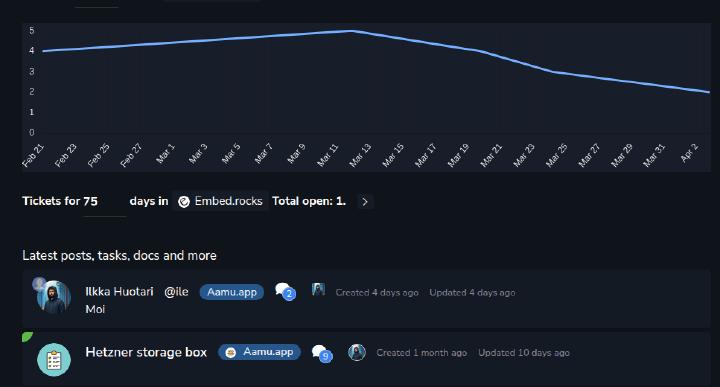Working collaboratively can sometimes feel like a mess. Too many apps, scattered chats, docs and tasks all over the place. Aamu.app is here to change that. It’s an all-in-one tool that brings everything your team needs into one spot, so you can stop juggling and start getting stuff done.
What Makes It Cool?
Here’s why Aamu.app feels like a breath of fresh air ⛅️ :
Aamu.app contains the most often used (by metric chosen by me) SaaS apps in one package. It’s got tasks tracking (with different views like a kanban board, a synced calendar), chats and posts, document editing, video calls, a helpdesk, emails, graphic design, a form builder and even databases. And what’s more — you can use many of these together — compounding their usefulness.
It makes collaboration between all of these apps easy. One unified user interface, and basically one app.
Whether you’re a tiny crew or a bigger group, it’s built to cut down on the chaos of using a bunch of different tools.
Plus, it saves you from paying for a million separate subscriptions.
💡 Pro-tip: if you are doing some long-term work in a document, you can always open a new tab, so you don’t have to interrupt the work in any place.
Features
So, let’s take a closer look at the features.
But before that, let me say that all the features work by using the keyboard only—you rarely need to touch the mouse, unless you want to, of course.
And on top of that, all features and all the data is real-time, and every user can edit everything at the same time — the data is automatically synced in real-time, and you will always see the up-to-date version of any data, anywhere.
So, those features I promised:
Tasks: Keep track of what needs doing with a kanban board, a list or a calendar. There exists an appropriate view for every occasion.
Work Together, Live: Edit documents as a team without the “which version is this?” confusion. It even has Penpot 2.x built in—a free design tool—so you don’t need something like Figma.
Talk Without the Noise: Chat in groups, post updates, or hop on a video call with LiveKit. It’s all there, no extra apps required.
Helpdesk: Got customers? The helpdesk handles live chats and emails, making it easy to stay on top of “tickets”.
Databases for Anything: Use them for customer tracking, a website, a blog or whatever you need. With GraphQL, you can get the data out (or put it in if you so wish).
A Form Builder: collect data with a form and store it into the Database.
Combine them: This blog that you are reading has been written with the Docs and stored in the Database — and then built into the real site (with open source tools).
Pricing
We are innovative here as well—you can pay what you want. Or more appropriately, what you think this is worth for you and how much you can afford to pay. From 0 to as much as you want.
We want to test if this model works. It feels fair to us, hopefully it proves to work.
What About That Name?
Aamu means “morning” in Finnish. I think it’s also quite a beautiful name. And it comes early in the alphabetic. It’s simple and distinctive. And most people start working in the morning (not me). 😆
Should You Trust This Tool?
Absolutely! As the founder, I bring years of experience as an entrepreneur and programmer. My earlier venture, Embed.rocks, has been reliably serving paying customers since 2016, demonstrating our commitment to quality and trust.
What’s more, there are no major costs involved in running Aamu.app, so it can’t really go bankrupt.
At the moment the service is run by one person only, so that’s the biggest risk—if something were to happen to me. When possible, I will take care of this issue too.
